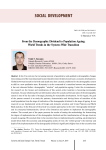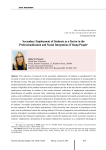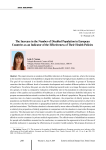Ocial development. Рубрика в журнале - Economic and Social Changes: Facts, Trends, Forecast

From the demographic dividend to population ageing: world trends in the system-wide transition
Статья научная
In the 21st century, the increasing intensity of quantitative and qualitative demographic changes is becoming one of the most important factors that determine the direction of socio-economic development. Global downward trends in the birth and death rates have created conditions for the demographic system to shift to a new qualitative state. Humanity is at the crossroads of a transition between two phenomena it has not witnessed before: demographic “window” and population ageing. Under the circumstances, the research on the factors and implications of this system-wide transition is becoming increasingly important, because obtaining relevant information about the actual and forecast states of the demographic system is one of the key tasks of strategic planning for sustainable development. In this regard, the goal of the present research is to study the patterns, characteristics and driving forces of transition of the world population from the stage of realization of the demographic dividend to the stage of ageing. In our research we use fundamental works of foreign and domestic scientists and United Nations and World Bank statistics. In the first part of the article we consider approaches to the term “demographic dividend” and its conceptual substantiation, drivers of its formation and options to implement the demographic window. The second part of the paper presents the results of testing the methodology for determining the degree of implementation of the demographic dividend and the transformation of the age structure towards its ageing. We conclude that in the countries that are implementing the catching-up development model (from both the economic and demographic points of view; the “yellow group”) the intensity and depth of the implementation of the demographic dividend is significantly higher than in the countries that have already completed it (mainly developed countries - the “red group”). At the same time we argue that the width of the demographic window of opportunity is directly proportional to the scale of potential impact of population ageing, which inevitably follows the stage of the dividend implementation.
Бесплатно

Статья научная
The relevance of research on the secondary employment of students is emphasized by the necessity to study its mixed impact on the professionalization and social integration of young people in the Russian society. The goal of this article is to clarify the meaning of secondary employment for the professionalization and social integration of young people in modern Russia on the basis of empirical data analysis. Originality of the problem statement and its solution are due to the fact that we consider students’ employment motivation in relation to the results achieved, realization of employment expectations, identification of possible outcome from combining studies and work, including the description of studies-work combination results for social and personal development of students and selection of several functions of young people’s secondary employment. Empirical basis of the research is complied from the results of author’s interviews with working students (2011 and 2017). The research showed the hierarchy of students’ secondary employment motives: financial motives are on the top and professional ones are less important. We note relative permanency of this hierarchy and a decrease in importance of the early start of professional carrier for working students. Division of pragmatic and professionally oriented motives of students’ secondary employment is explained. We point out that many working students have implemented their financial expectations, which reveals the leading role of the economic function in students’ employment; devaluation of secondary employment experience as a competitive advantage in social and labor relations; non-productivity of performed work for professionalization of the majority of working students. At the same time, we reveal the significant impact of work on the formation of common labor culture in students. Necessity to strengthen professionalization function within students’ secondary employment is revealed, and practical recommendations are given. The results of this research may help develop theoretical models and accumulate empirical data in the sphere of economic sociology, labor sociology, and youth sociology. It can be used by public authorities, employment services, and vocational education institutions.
Бесплатно

Статья научная
The paper presents an analysis of disability indicators in European countries, where the increase in the number of persons with disabilities is largely determined by the high primary disability in the elderly. The goal of our research is to identify distinctive characteristics of disability in groups of European countries that have different levels of economic development and conduct different policies in the field of healthcare. To achieve this goal, we solve the following research tasks: we arrange European countries into groups; we make a comparative evaluation of disability rate in the population in selected groups; we analyze of the quality and accessibility of healthcare as a factor that influences disability indicators; we propose recommendations aimed to reduce the disability rate in Russia’s population. We group European countries into six clusters according to disability indicators, the proportion of elderly persons in the population and healthy life expectancy at age 60. The greatest similarity of these parameters is observed in the countries that have similarities in geographical position and historical experience of participation in political associations. The Russian situation is characterized by worse values of healthy life expectancy and a relatively low proportion of elderly population in comparison with the situation in most other European countries. The discussion part of our paper considers the quality and availability of healthcare. In Russia, a significant part of older citizens who have the greatest risk of developing disabling pathologies cannot afford to receive treatment in private medical organizations. The effectiveness of rehabilitation measures for people with disabilities remains low. In conclusion, we summarize the arguments in favor of the use of disability indicators in assessing the effectiveness of countries’ health policies. We propose directions of work to reduce disability in Russia. The results of the study can be useful for social management workers and for scientists whose research interests affect the problems associated with disability of the population.
Бесплатно

